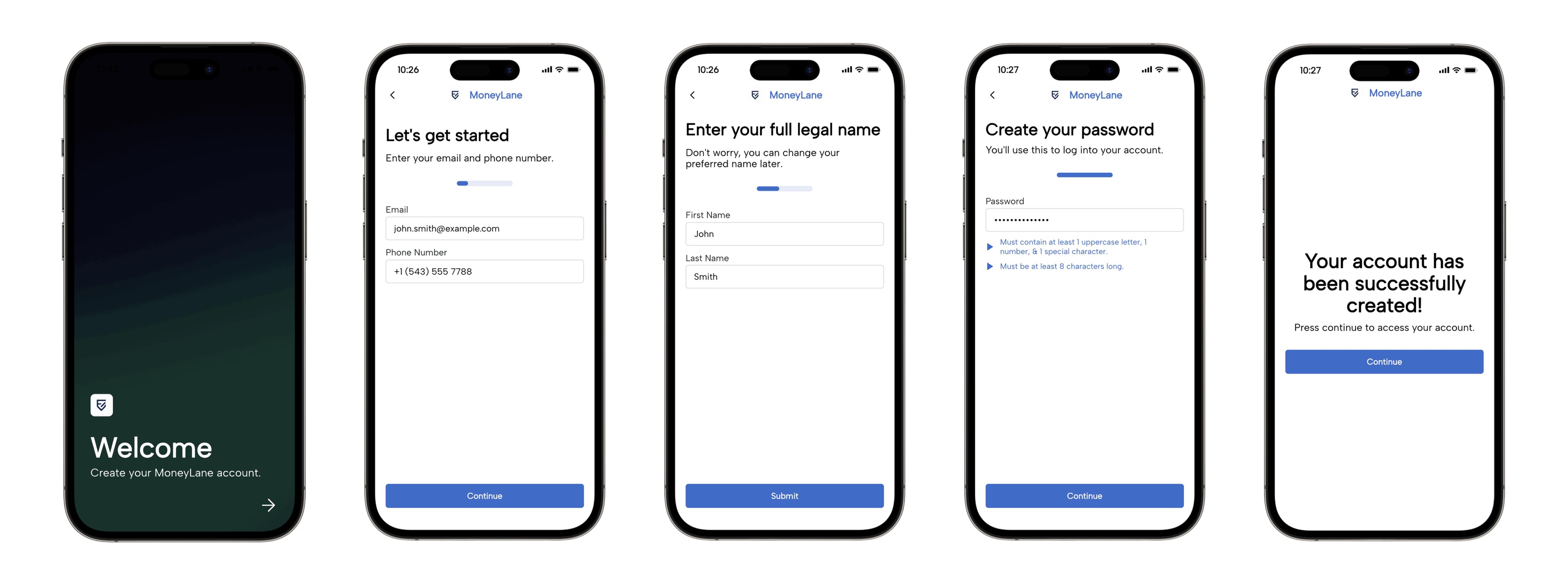
Consumer Onboarding
Socure’s AI-powered platform delivers the most accurate identity, fraud, and risk decisions in milliseconds, effortlessly verifying every demographic.
Future-proof your customer onboarding
The opportunity
Say ‘yes’ to more good users, stop fraud in its tracks and streamline customer onboarding with real-time, adaptive identity workflows.
Socure Customer Onboarding FAQ Answers
Identity verification during new account creation is the process of confirming a user’s identity at the time of application, ensuring they are who they claim to be before granting access to a service, platform, or ecosystem. This process seeks to address two fundamental questions:
- Does this person exist?
- Are they who they claim to be?
The rise of digital onboarding, accelerated by the COVID-19 pandemic, has significantly transformed identity verification. Traditionally centered around compliance with Know Your Customer (KYC) and Anti-Money Laundering (AML) regulations in highly regulated industries, identity verification now extends across a broad spectrum of sectors. These processes aim to ensure only legitimate and trustworthy users are granted access, safeguarding against identity fraud. The level of scrutiny applied is tailored to the organization’s risk tolerance and the potential risk posed by the new user.
Nearly all industries rely on identity verification as part of customer onboarding, including financial institutions, fintech companies, public sector organizations, healthcare providers, gaming platforms, marketplaces, cryptocurrency exchanges, and more. While often associated with digital applications, identity verification processes also apply to contact centers and in-person account openings.
There are three common onboarding workflows for new customer onboarding:
- Traditional Onboarding: Collecting comprehensive information upfront for verification.
- Progressive Onboarding: Gradually gathering data as the user engages with the platform.
- Prefill Onboarding: A streamlined process that collects minimal information directly from the consumer, while leveraging an identity verification provider to automatically populate additional details by matching existing customer records.
By adopting the appropriate workflow and identity verification methods, organizations can enhance security, improve user experience, and mitigate risks effectively.
The traditional onboarding process involves collecting comprehensive information directly from the customer at the initial point of interaction. Customers are typically required to provide extensive personal details, such as name, address, date of birth, identification documents, and sometimes financial information. This information is then manually or digitally verified through identity verification checks, which may include document authentication, biometric verification, or database cross-referencing. While this method is thorough and ensures compliance with regulatory requirements such as Know Your Customer (KYC) and Anti-Money Laundering (AML) mandates, it can be time-consuming and may introduce friction to the customer experience. Despite its slower pace, traditional customer onboarding remains a preferred choice in industries where high levels of security and regulatory compliance are critical, such as banking, healthcare, and government services.
Progressive onboarding is a dynamic, user-centric approach to account creation and customer onboarding that unfolds in a step-by-step manner. Instead of requiring users to complete all tasks upfront, this method introduces and guides them through only the necessary steps at the appropriate time, minimizing friction and reducing the risk of abandonment. By breaking down the process, progressive onboarding ensures users are not overwhelmed and creates a smoother, more intuitive experience.
For instance, a customer might initially be asked to provide only basic information to set up their account. Once the account is successfully created, additional steps—such as submitting further identification or verifying financial details—can be introduced as needed, such as when initiating transactions or engaging in money movement. This tailored, phased approach not only enhances user satisfaction but also optimizes compliance and security by aligning identity verification efforts with user actions.
Prefill onboarding is an innovative approach designed to simplify and expedite the account creation process by leveraging existing data. Rather than requiring users to manually enter all their personal information, this method collects minimal input directly from the customer—such as a name, email, address, or phone number—and uses an identity verification provider or pre-existing records to automatically populate additional required fields. By matching the customer’s information against reliable databases or previously stored proles, the system can accurately and efficiently complete the necessary details. This approach reduces friction, enhances user experience, and significantly shortens the time required to onboard a new customer.
For example, after entering basic information, a user might see their address, date of birth, and other details automatically filled in, allowing them to quickly review and confirm the accuracy of the data. Prefill onboarding is particularly beneficial in industries where speed and convenience are critical, such as online gaming, e-commerce, and digital services, that do not have the regulated process standards that apply to traditional financial institutions. By minimizing manual input, organizations can improve completion rates, reduce errors, and create a seamless onboarding journey.
Identity verification enhances the customer onboarding experience by reducing identity fraud while ensuring a smoother and more consistent process for users. As organizations grapple with the challenge of balancing a seamless customer onboarding journey with robust account security, identity verification plays a pivotal role. Instead of relying on a rigid, one-size-fits-all approach, businesses can adopt dynamic risk-based strategies that tailor the identity verification process to the risk level of each user.
For most users (typically 75% or more, who are low-risk), low-friction identity verification ensures swift customer onboarding, minimizing delays and enhancing satisfaction. For higher-risk users, additional identity verification layers and added friction may be desired—such as enhanced document checks or biometric authentication—can be implemented to mitigate fraud risks without compromising the integrity of the process.
If automated systems detect inconsistencies or potential risks, they may escalate cases to manual review. During this process, employees carefully analyze verification details and personally verify the user’s identity. However, manual reviews are inherently slower, costlier, and more prone to human error. To address these challenges, organizations increasingly seek advanced identity verification systems that leverage AI/ML to maximize accuracy, auto-approvals, and minimize the need for manual intervention while maintaining a secure and efficient customer onboarding process.
In addition to detecting and stopping fraudulent activity, identity verification helps build customer trust, reduces costs by catching identity fraud early, and supports long-term business growth by establishing a secure, reliable customer base. Accurate identity verification can also enhance a company’s reputation by demonstrating a sincere commitment to the security of its customers. With less fraud, reduced friction, and increased trust, users are less likely to abandon the customer onboarding process, leading to lower user acquisition costs and greater revenue growth.
Detecting identity fraud during customer onboarding is imperative for preventing financial losses, ensuring regulatory compliance, and maintaining a trustworthy reputation. Across all industries, businesses are seeing increased rates of first-party, third-party, and synthetic identity fraud. With the rise of generative AI, bad actors have new sophisticated tools at their disposal, including flawlessly-generated phishing scripts, LLMs for creating convincing sets of personally identifiable information (known as ”fullz”), and Deepfakes.
Implementing stringent identity verification has never been more vital. By catching identity fraud during account verification, companies prevent bad actors from gaining access to their ecosystem, stopping illegitimate activity before it can cause damage.
Socure’s AI-powered platform through RiskOS™ sets the benchmark for accuracy, speed, and adaptability in identity, fraud, and risk decisioning. With decisions delivered in milliseconds, Socure effortlessly verifies diverse demographics through intuitive, no-code workflows, ensuring a seamless customer onboarding experience for all users.
Unlike legacy tools that heavily rely on credit data and often struggle with thin-file demographics such as younger Gen Z consumers or new-to-country immigrants, Socure’s advanced analytics and unmatched data sources empower organizations to significantly increase verification rates for these underserved groups. This not only enhances inclusivity but also drives sustained user acquisition and revenue growth.
Socure provides a flexible, end-to-end platform tailored to organizational needs, supporting traditional, progressive, and prefill onboarding workflows. It minimizes consumer friction while delivering unmatched precision and efficiency. The platform integrates a suite of industry-leading solutions, including:
- Digital Intelligence
- Verify+
- eCBSV (Electronic Consent-Based Social Security Verification)
- Global Watchlist Screening with Monitoring
- First-Party Fraud Detection
- Sigma Identity Fraud & Synthetic Fraud Models
- Alert List Checks
- Email, Phone, and Address Verification
- One-Time Passcode (OTP)
- Predictive Document Verification
- Selfie Reverification
Socure’s identity verification capabilities are powered by the market’s largest dataset of known good and bad identities, drawn from a vast network of thousands of customers. The platform leverages 30,000+ fraud-specific risk signals and patterns, enabling unmatched accuracy. While competitors often rely on rigid, rules-based point solutions that funnel many users into manual reviews, Socure’s holistic 360° identity view achieves auto-approval rates of up to 99% and reduces manual reviews by up to 49.4%.
With Socure, organizations can unlock faster onboarding, enhanced fraud prevention, and seamless compliance, all while delivering a frictionless experience for users across all demographics.
Schedule a demo or talk to our experts to see how Socure can transform your new customer onboarding and identity verification process.
Let us prove it.
Scale your organization with confidence.



